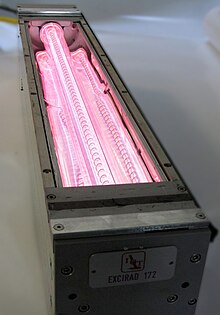Excimer

The term excimer is an acronym from the short form of " exci ted di mer " ('stimulated dimer '). It is a short-lived particle that consists of two or more connected atoms or molecules . The specialty is that the excimer can only be formed when a binding partner is in an excited state . If this particle loses energy , the binding partners separate and return to the ground state . Light is often emitted here . The emission band is broad and more red-shifted than the emission band of the excited monomer . This property can be used spectroscopically to identify excimers.
By definition, an excimer molecule consists of two or more atoms of the same chemical element . When it comes to atoms of different elements, one speaks of an exciplex . In the literature, however, this fact is seldom taken into account and therefore exciplexes are often incorrectly referred to as excimers.
Use in excimer lasers
In excimer lasers , the properties of excimers (or today mostly exciplexes) are used: the population inversion required for laser technology is already given by the formation of the molecule, since the ground state must not be occupied. The disintegration time is i. A. a few nanoseconds (ns).
Excimer lasers, which emit in the ultraviolet spectral range, have gained practical importance in medical technology and in photolithography (a field of semiconductor production ). The laser-active medium consists mainly of the following excimers (fluorine) or exciplexes:
- Fluorine (F 2 ) with an emitted wavelength of 157 nm
- Argon fluoride (ArF) 193 nm
- Krypton fluoride (KrF) 248 nm
- Xenon chloride (XeCl) 308 nm or
- Xenon fluoride (XeF) 351 nm.
See also
literature
- A. D. McNaught, A. Wilkinson: excimer . In: IUPAC Compendium of Chemical Terminology (the “Gold Book”) . 2nd Edition. Blackwell Scientific Publications, Oxford 1997, ISBN 0-9678550-9-8 , doi : 10.1351 / goldbook.E02242 (English, corrected version (XML; 2006–) by M. Nic, J. Jirat, B. Kosata; with updates by A. Jenkins - Version: 2.3.3).